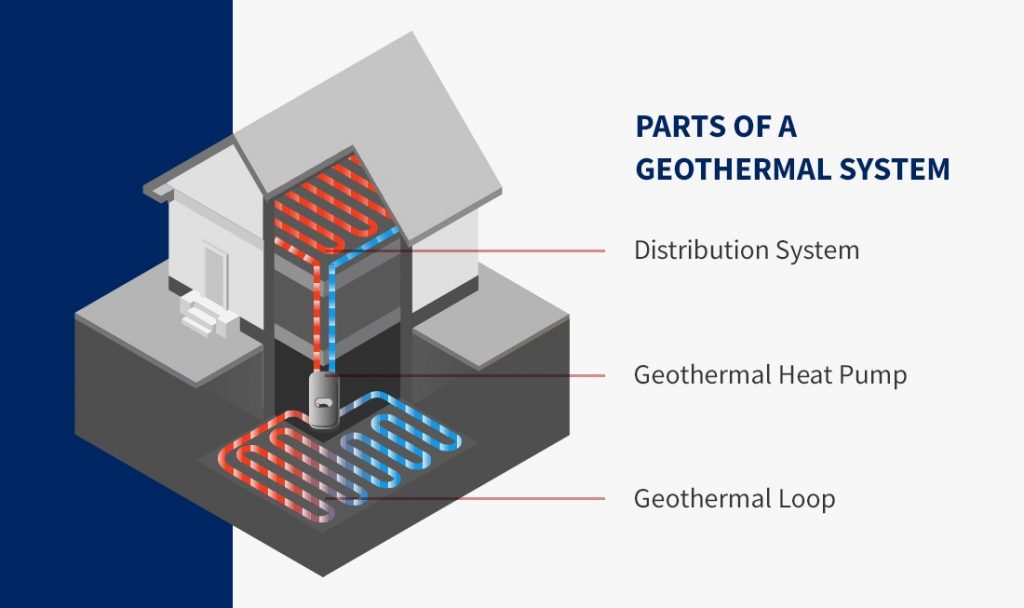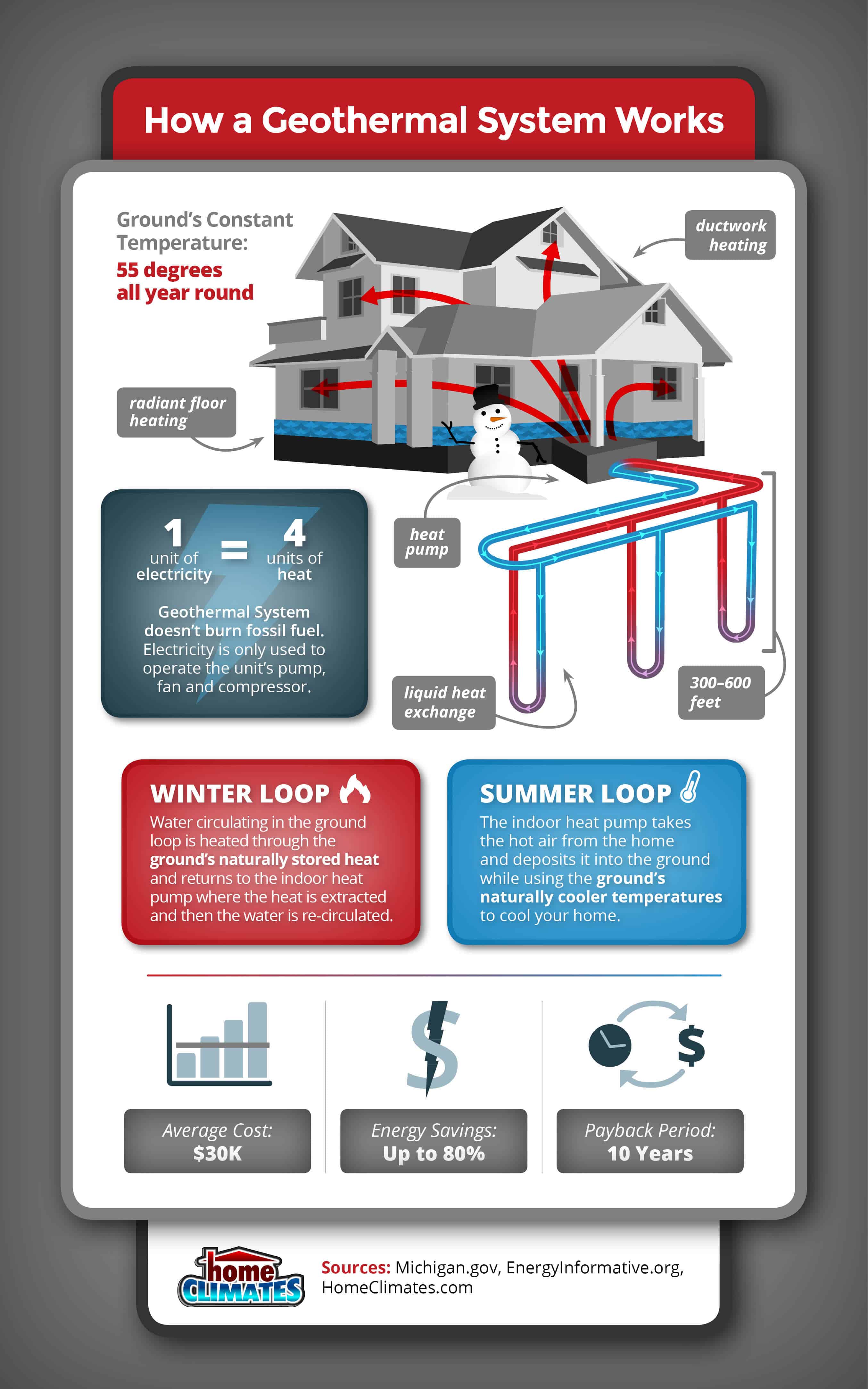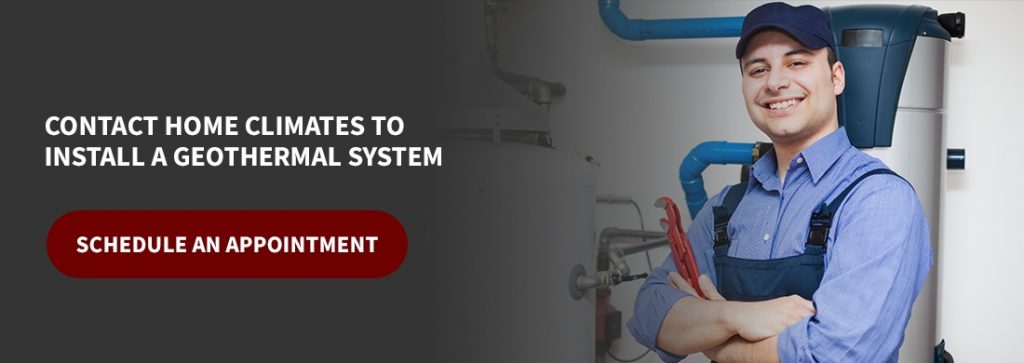How Does a Geothermal System Work?
Feb 16, 2016
Do you want to save money on your electric and hot water bills? A typical American family pays an average of $115 a month on home electricity, according to the U.S. Energy Information Administration.
You can save up to 80% each year on hot water, heating and cooling by switching from a traditional HVAC to a geothermal heat pump.
What is geothermal heating?
A geothermal heating and cooling system is an energy-efficient system that uses the natural stable ground temperature to warm homes in the winter and keep them cool in the summer. Geothermal systems have three essential parts: the air handling system that transfers the air, the groundwater heat exchanger that takes heat from the ground or transfers heat back into the earth and the geothermal loop that moves heat between the air handling system and the groundwater exchanger.
How Does A Geothermal System Work?
After a geothermal system is installed, the heat pump, usually located in the garage or basement, circulates liquid through pipes 300 feet deep into the ground. These are sometimes referred to as “loops” and they absorb the temperature that is distributed into the ground from the sun. The liquid in the loops circulates back up to the geothermal heat pump which heats or cools your home. In the winter, the heat from the liquid is extracted and distributed around the home. In the summer, heat is taken from the home into the liquid which carries it into the ground to cool.
Because of how a geothermal heating and cooling system works, it doesn’t require fossil fuels or a lot of electricity, it is environmentally friendly. In fact, it’s recognized by the United States Environmental Protection Agency (EPA) as a clean, renewable source of energy that is greatly underutilized.
The following infographic helps clarify how a geothermal system works.
Feel free to add this graphic to your site with attribution back to the original. Copy and paste the code as it appears below:
<p><a href='https://homeclimates.com/blog/how-geothermal-systems-work'><img src='https://homeclimates.com/wp-content/uploads/2018/09/how-a-geothermal-system-works.jpg' alt='' width='100%' border='0' /></a></p>
What are the Parts of a Geothermal System?
Geothermal systems are a popular choice for homeowners because they provide more energy-efficient solutions for heating and cooling. Each piece that makes up the geothermal cooling and heating system plays a significant part in the system’s function. These components are very different than the ones you would find in a typical HVAC system. Learn about the various parts that make up a geothermal cooling and heating system.

Geothermal Loop
No matter how freezing or sweltering the outdoor temperature gets, the underground temperature remains relatively consistent year-round. The geothermal loop is a path of pipes that travel deep enough to reach the zone that stays at this constant temperature. This loop of pipes contains water or a mixture of water and antifreeze. This loop system circulates the liquid and either brings heat to the geothermal system or cools it down.
Companies can place the plastic tubing either vertically or horizontally underground, depending on the property.
- Horizontal: Horizontal pipe placement is typical for residential properties, where the land generally has more room for the pipes to be horizontal under the ground. The installation cost for horizontal geothermal loops is cheaper because installation crews don’t have to dig as deep into the ground.
- Vertical: Vertical pipe placements are usually for large businesses and commercial buildings like schools or churches. This installation option requires the pipes to be deep underground to avoid affecting landscaping or certain soil disturbances.
You can also install these geothermal loops in a suitable body of water on the property. Lake or pond loops are a budget-friendly option that delivers similar results. The body of water must meet specific criteria before you install a geothermal loop system.
Geothermal Heat Pump
The geothermal heat pump is the central hub for the machine in the geothermal system, which includes essential components like the compressor and the heat exchanger.
The heat pump’s job is to transfer the water or water mixture through the geothermal loop to move heat through the system. The geothermal pump can connect to any geothermal loop configuration to heat or cool your home or building.
Distribution System
Geothermal heat pumps’ distribution system transfers the hot or cold air throughout your home. Two different options are available to take care of the property’s heating and cooling needs.
The first is a forced-air system. Forced air requires ductwork and an air handler to transfer conditioned air around the home.
The second option is a water-to-water system. Pipes will run through your walls or flooring of your home and transfer heat. The hot or cool liquid they carry comes from the geothermal loop system that connects to the main geothermal heat pump.
Open-Loop vs. Closed-Loop Systems
You can install geothermal loops differently, depending on your property’s various factors. The two categories of geothermal systems are closed-loop and open-loop systems.
Closed-loop systems use a water mixture in the pipe system to transfer heat from the ground to the structure. You can construct closed-loop systems horizontally, vertically, a variation of the two or submerged in a body of water.
Open-loop systems carry groundwater through the pipes to move heat. These geothermal ground loop systems can take in groundwater, or you can install the system in a body of water.
What Are the Benefits of Geothermal Systems?

Geothermal AC and heating systems use sustainable resources and provide an excellent option for people or businesses to control their indoor temperature. Geothermal energy has a lot of potential for widespread adoption in the future.
Consider the main benefits of using geothermal energy as your heating and cooling system.
- Environmental impact: Geothermal energy is better for the environment than traditional energy sources. The carbon footprint of fossil fuels is much larger than the one associated with using geothermal energy. Using a geothermal system to control your property’s temperature can be more environmentally conscious.
- Unlock potential: We are far from our peak potential for geothermal energy solutions. In the future, the world could see a significant increase in the availability of geothermal energy systems. There are many upsides to this energy source’s growth.
- Renewable: We can use geothermal energy for more than a lifetime. Using a renewable source benefits our shared environment and doesn’t contribute as much to the climate crisis.
- Sustainable: Geothermal energy is a stable resource and is consistently available, unlike other energy sources such as solar or wind.
- Heating and cooling: An impressive aspect of geothermal energy is how efficient it is at heating and cooling. All the system’s parts work to provide structures with sustainable heating and cooling solutions.
- No fuel: The process of geothermal heating is natural and doesn’t require any fuel to operate. Fossil fuels are nonrenewable resources and adversely impact our environment, but geothermal energy represents a healthy alternative.
- Reliable: This type of energy source is reliable because we know it will always be available. Other energy sources can be finite and may not be available in the future.
- New technology: Industry innovators are always developing new technology and completing more research about geothermal energy. The industry will grow and continue improving.
Geothermal energy’s tremendous environmental impact is unmistakable. It’s a clean resource to consider using for your home or structure.
How Does a Geothermal System Save You Money?
Geothermal systems save you money because they get their energy from the earth’s core and don’t have to work as hard to heat or cool your home. After the Home Climates team installs your geothermal system, the heat pump, usually located in the garage or basement, circulates liquid through underground pipes, or loops. These loops absorb the warmth from the surrounding earth, which comes from the sun. The liquid in the loops circulates back up to the geothermal heat pump, which heats or cools your home. In the winter, the system extracts heat from the liquid and distributes it around your home. In the summer, the system transfers heat from the property into the liquid, which carries it into the ground to cool.
Geothermal heating and cooling systems don’t require fossil fuels or a lot of electricity, making them an environmentally friendly option. The U.S. Environmental Protection Agency recognizes geothermal as a clean, renewable energy source that is vastly underused. There is also a federal tax credit that will pay for 30% of installation costs. Find out more about this tax credit!
geothermal consultations in central pa
HOW DOES A GEOTHERMAL SYSTEM BENEFIT THE ENVIRONMENT?
Geothermal heating and cooling systems take advantage of our planet’s surface temperature to control your home’s temperature using underground piping. Heat from the sun warms our planet’s ground temperature, so technically, you’re heating your home with solar energy, which is a renewable resource. By doing this, you’re reducing the other fuels you would usually use to control your home’s heating!
Geothermal systems will last a long time, around 25 years for indoor components and 50 years for the loop systems. Their longevity makes them an excellent investment for your property.
Contact Home Climates to Install a Geothermal System
If you’re interested in enjoying the benefits of a geothermal heating and cooling system in your home, Home Climates has a team of experts that can get the job done. We can help you decide on which type of geothermal system is best for your property.
Geothermal systems allow you to efficiently control your indoor temperature while you save on your energy bills. You’ll also be making a positive impact on the environment.
Have more questions about how a geothermal heat pump works? Contact us today, and we’ll calculate how much money you can save by installing a geothermal heating and cooling system in your home. You can also schedule an appointment online for a free estimate or request repairs.
Interested in Geothermal Heating?

Home Climates Review Scored as of 9/22/22


